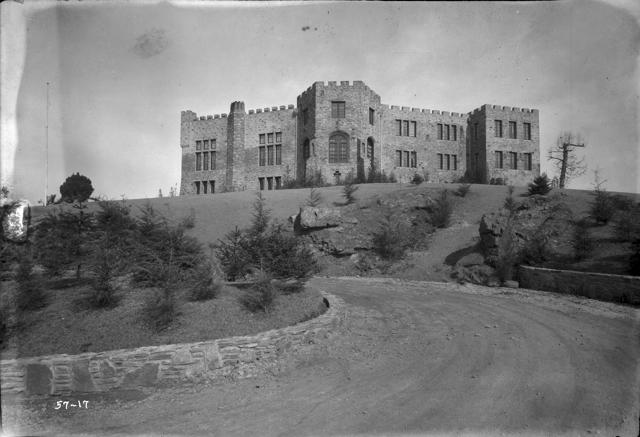Everybody dreams of being king for a day, but I became a king for several years. Not really, though I did get to live in a real castle, which was certainly a very special life experience.
High above Asheville, right off Town Mountain Road, sits an imposing stone castle offering spectacular panoramic views. The 20,000-square-foot structure has no real architectural peer in our area. Sure, it’s smaller than Biltmore House and entirely different in style, but as we used to say, we were No. 2, so we had to try harder.
Fred Seely built the castle on a promontory known as Overlook Park, so he named his home Overlook Castle. Locals, however, call it Seely’s Castle.
Seely and his father-in-law, the patent-medicine tycoon E.W. Grove, built the Grove Park Inn and developed the adjacent residential neighborhood. In designing the inn, Seely used granite from a quarry just north of where the castle is now, specifying that big boulders be used so no mortar joints would show.
After the inn was completed in 1913, however, he had a huge amount of small stone left over. So the next year, he began building the castle, hiring Italian masons who’d worked on Biltmore Estate. The stone walls they crafted looked like a magnificent tapestry.
Seely actually never finished the building: To this day, there’s an incomplete stone observatory on the top. This may have been because no property taxes were levied on an unfinished building. Seely’s family moved in around 1915 and lived there until his death in 1942.
His wife, Evelyn Grove Seely, then moved to the Battery Park Hotel — which her father and husband had also built, along with the Vanderbilt Hotel and the Grove Arcade. She sold the castle at a reduced price to Asheville-Biltmore College, which began operations there in 1949.
Over the years, I’ve enjoyed hearing from former students at this uniquely situated institution of higher learning, who’ve shared their fond memories of that unusual experience.
In 1961, the college moved to a new campus on Weaver Boulevard, becoming the University of North Carolina at Asheville. The castle and 29 acres were then sold to two of the owners of the Holiday Inn chain. They built the Tiara Apartments on the north end of the tract. If those apartments (now known as the 647 Town Mountain Road Condominiums) look like a Holiday Inn to you, it’s because they used the same design.
They had no use for the castle, however, so they put it on the market. I will address my ascendency to “king of the castle” status later in this saga. First, I want to share some of the many legends I’ve heard concerning life at the castle during the Seely family’s tenure.
The caretaker’s son, who grew up in a house on the property, told me that a dozen employees tended to the house and grounds. The men walked up the mountain every day, carrying their own lunch and working 12-hour shifts for $2 a day. He said Seely was allergic to poison ivy, and in the summertime, one man was assigned full time to pulling up the noxious weed.
Mrs. Seely grew exotic roses and had a prize-winning rose garden. There’s also a large greenhouse on the property, which the university used as a chemistry lab.
Mr. Seely wanted a tennis court built and supposedly badgered the contractor to lower the price. In response, the contractor reduced the size of the court, and Seely didn’t realize it till after he’d paid the contractor. The outline of the tennis court remains to this day.
The family apparently used the castle as their summer home, spending much of the winter in the Far East buying quinine, the main ingredient in Grove’s Chill Tonic, a popular patent medicine that claimed to cure colds and prevent malaria.
Seely entertained many famous and important people at the castle. He was friendly with Henry Ford, Harvey Firestone and Thomas Edison, who would visit Asheville and camp on the castle grounds.
Edison is said to have had a hand in designing the electrical system, which included such advanced features as a built-in switch that turned on the light on when one opened the closet door.
Seely attended Princeton as a grown man, studying architecture. During this period, he became friendly with Woodrow Wilson, who was then the university’s president.
Seely later became a significant fundraiser for Wilson’s presidential campaigns. During his second term in office, Wilson suffered a stroke, and legend has it that the government was secretly being run by his wife and “Colonel” Edward House, the president’s longtime adviser. Every day, to fool the public, they would pretend to wheel Wilson out onto a porch at the White House to enjoy the afternoon sun, but this was just a stand-in: Supposedly, Wilson was actually being kept out of sight in the castle’s master bedroom.
It’s also said that papers related to the Teapot Dome scandal, having to do with oil leases during the Harding administration, were locked in the enormous safe in the counting house in the castle’s west wing. It is not known what connection, if any, Seely had with all that.
I hope this whets your appetite. In future installments, I’ll explain how I acquired this unique architectural wonder and share tales of my life as a monarch.
— Asheville native Jerry Sternberg, a longtime observer of the local scene, can be reached at gospeljerry@aol.com.




Jerry Sternberg’s recollections of local history are gems, well written and full of information and insight.